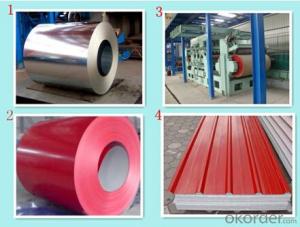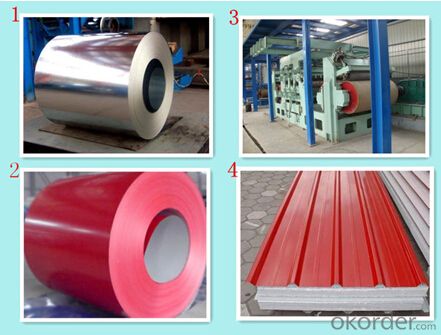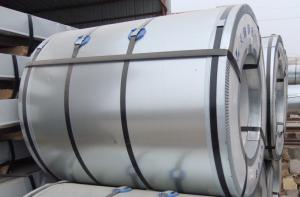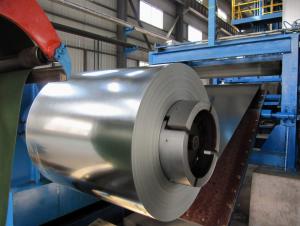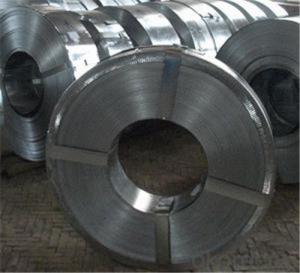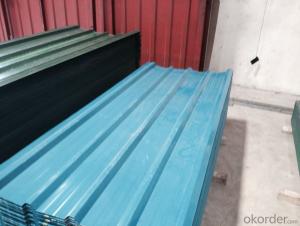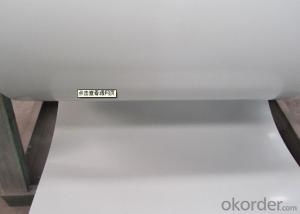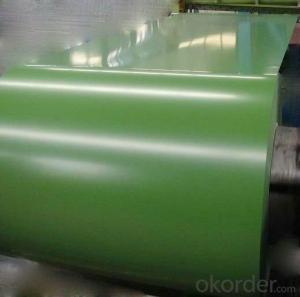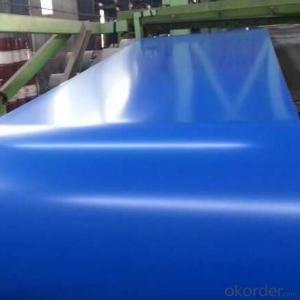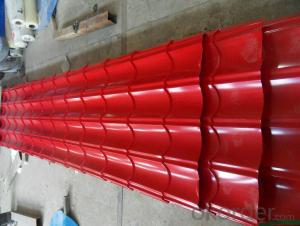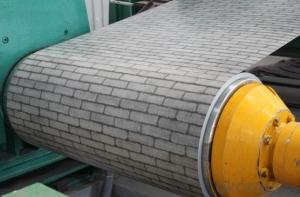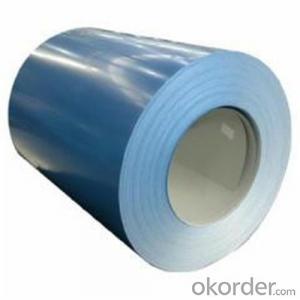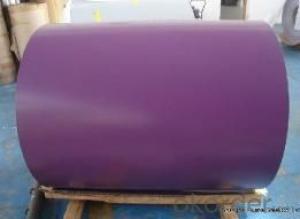Prepainted Galvanized/Aluzing Steel coils for Roofings
- Loading Port:
- Shanghai
- Payment Terms:
- TT OR LC
- Min Order Qty:
- 50 m.t.
- Supply Capability:
- 10000 m.t./month
OKorder Service Pledge
OKorder Financial Service
You Might Also Like
Specification
Product Details
Basic Info.
Model NO.:G550, FULL HARD, SGHC
Type:Steel Coil
Standard:ASTM, GB, JIS
Certification:ISO, SGS, BV
Surface Treatment:Coated
Technique:Hot Rolled
Special Use:High-strength Steel Plate
Base Metal:Galvanized or Galvalume Steel
Width:914/1000/1200/1219/1220/1250mm
Thickness:0.16-1.2mm
Zinc-Coating:Z50-150G/M2 or Az40-100G/M2
Top Side Painting:15-25 Micron
Back Side Painting:5-8 Micron
Colour:Ral Standard or According to Customers′ Requirment
Coil Weight:3-6 Mt
Coil ID:508/610 Mm
Export Markets:North America, South America, Eastern Europe, Southeast Asia, Africa, Mid East, Eastern Asia
Additional Info.
Packing:Seaworthy Packing
Standard:0.135-1.2MM
Origin:China, Shandong
HS Code:72107000
Production Capacity:180000mt
Product Description:
1. Standard: AISI, ASTM, BS, DIN, GB, JIS, ASTM, JIS, GB
2. Steel Grade: DX51D, SGCC, SGCH, SPCC, SPCD, DC01, ST12, ST13, Q195, 08AL
3. Thickness: 0.13-0.5mm
4. Width: 600-1250mm
5. Length: Up to The Thickness or as require
6. Spangle: Zero, Mini, Regular, Big, Skin Pass
7. Audited Certificates: BV, SGS, ISO, CIQ
8. Zinc Coating: 40g-200g
9. Surface: Chromated, dry/oiled, Cr3 treated anti-finger
10. Package: Standard exporting package (or as required)
11. ID: 508/610mm
Specification:
| commodity | Color Coated Steel Coil (PPGI/ PPGL) |
| Techinical Standard: | JIS G3302-1998, EN10142/10137, ASTM A653 |
| grade | TSGCC, TDX51D / TDX52D / TS250, 280GD |
| Types: | For general / drawing use |
| Base metal | galvanized, galvalume, cold rolled steel |
| Thickness | 0.14-1.0mm(0.16-0.8mm is the most advantage thickness) |
| Width | 610/724/820/914/1000/1200/1219/1220/1250mm |
| Type of coating: | PE, SMP, PVDF |
| Zinc coating | Z60-150g/m2 or AZ40-100g/m2 |
| Top painting: | 5 mic. Primer + 15 mc. R. M. P. |
| Back painting: | 5-7 mic. EP |
| Color: | According to RAL standard |
| ID coil | 508mm / 610mm |
| Coil weight: | 4--8MT |
| Package: | Properly packed for ocean freight exportation in 20' ' containers |
| Application: | Industrial panels, roofing and siding for painting / automobile |
| Price terms | FOB, CFR, CIF |
| Payment terms | 20%TT in advance+80% TT or irrevocable 80%L/C at sight |
| delivery time | 25 days after recepit of 20% TT |
| Remarks | Insurance is all risks |
| MTC 3.1 will be handed on with shipping documents | |
| We accept SGS certificatation test |
Details of Type:

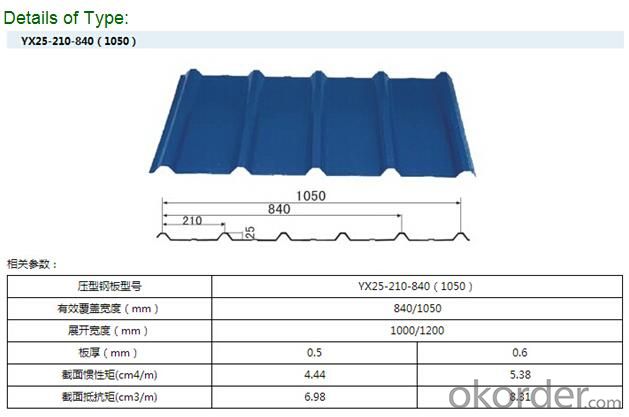
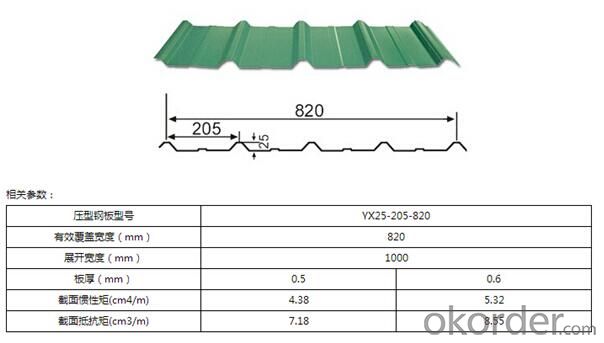
FAQ:
1.What's your MOQ?
25MT, it is for one container.
2.Do you have QC teams?
Yeah, sure, our QC team is very important, they will keep the quality control for our products.
3. What's your normal delivery time?
Our delivery time about 10-20days for standard sizes, if you have other requirements like hardness and width ,it is about 20-40days. But don't worry ,we also try our best for the delivery time ,because time longer and our cost is higher.
4.Are the products tested before shipping?
Yes, all of our PPGI and GI was qualified before shipping. We test every batch every day.
- Q: Just wondering how good are forge steel screw drivers, tool boxes(organisers) and pliers are, as screw fix are having a january sale, and looking to add to my tool collection. Thanks in advance
- Go craftsman not bad prices and lifetime warranty.
- Q: What are the different types of steel coil handling systems?
- There are several different types of steel coil handling systems, including coil upenders, coil cradles, coil transfer cars, coil tilters, and coil grabbers.
- Q: How are steel coils inspected for damage during transportation?
- Steel coils are inspected for damage during transportation through various methods such as visual inspections, magnetic particle testing, ultrasonic testing, and dimensional checks.
- Q: What are the common methods of joining steel coils together?
- The common methods of joining steel coils together include welding, mechanical fastening (such as using bolts or screws), and adhesive bonding.
- Q: Can steel coils be coated with UV-resistant materials?
- Yes, steel coils can be coated with UV-resistant materials.
- Q: I am reading the book The Cure For All Advanced Cancers by Hulda Regehr Clark.She writes for example: cancer can be caused by exposure to heavy metals, like nickel and chromium from stainless steel cookware. Stainless steel cookware releases chromium and nickel, two of the most carcinogenic metals.Are there any studies done measuring how much nickel and cadmium can be released from the regular use of stainless steel cookware?Is this a commonly accepted opinion that use of stainless steel cookware is dangerous?If not stainless steel, what kind of cookware to use? I heard that non-stick cookware also releases some harmful chemicals.
- The food safety standards for cookware are pretty stringent. Older items may be associated with problems - I know they used to make dishes with uranium-based paint - but food-grade stainless steel is safe.
- Q: Okay, I have looked all ovcer the net and it says diamonds are stronger, but why? I mean, why is diamonds used for the top equiptment rather than steel?
- Diamonds okorder
- Q: What are the common methods of inspecting steel coils for defects?
- There are several common methods used for inspecting steel coils for defects. These methods include visual inspection, ultrasonic testing, magnetic particle inspection, and eddy current testing. Visual inspection is the most basic method and involves physically examining the surface of the steel coil for any visible defects such as cracks, dents, or surface irregularities. This method is usually the first step in the inspection process and can quickly identify any obvious defects. Ultrasonic testing is a more advanced method that uses high-frequency sound waves to detect defects within the steel coil. A probe is used to transmit ultrasonic waves into the coil, and any internal flaws or defects will reflect the sound waves back to the probe. This method is effective for detecting defects such as voids, cracks, or inclusions within the material. Magnetic particle inspection is another commonly used method for inspecting steel coils. This technique involves magnetizing the coil and then applying iron particles to the surface. Any defects or cracks will cause a disturbance in the magnetic field, attracting the iron particles and making them visible. This method is particularly effective for detecting surface cracks or defects. Eddy current testing is a non-destructive method that uses electromagnetic induction to detect defects in the steel coil. A probe is used to generate an alternating magnetic field, and any changes in the electrical conductivity or magnetic permeability of the material due to defects will produce eddy currents. These eddy currents can be measured and analyzed to identify defects such as cracks, voids, or changes in material properties. Overall, these common methods of inspecting steel coils for defects provide various levels of accuracy and sensitivity, allowing for thorough inspections to ensure the quality and integrity of the steel coils. The choice of method depends on factors such as the type and size of defects to be detected, the required level of inspection accuracy, and the cost and time constraints of the inspection process.
- Q: I'm quite confused...i watched all of steel angel kurumi (the 28 episodes) and then continued to steel angel kurumi zero. it was an entire different story line with only the steel angels being the same. the world is different the guys are different, and there is a new character. Even the humor is gone. its like a whole different series. So what gives, what is the relationship between them?
- Steel Angel Zero is an OVA (Original Video Animation), a very short animation that went straight to DVD. It probably was written because Kurumi was so popular, and the producer wanted to check the waters for whether they should make a second season. It's pretty hard to keep track of what anime is which, especially in the more popular series. If you think Zero is worth zero, try Steel Angel Kurumi 2 (anime, 12 episodes), and Steel Angel Kurumi Encore (OVA, 4 episodes) as well.
- Q: which cost more: ALLOY, GUNMENTAL OR STAINLESS STEEL. GIVE ME AN IDEA OF THE COST OF EACH.
- Titanium alloy is. Its the hardest metal in the world and takes about 6 months to produce. I sell titanium juliets for 350.
Send your message to us
Prepainted Galvanized/Aluzing Steel coils for Roofings
- Loading Port:
- Shanghai
- Payment Terms:
- TT OR LC
- Min Order Qty:
- 50 m.t.
- Supply Capability:
- 10000 m.t./month
OKorder Service Pledge
OKorder Financial Service
Similar products
Hot products
Hot Searches
Related keywords
